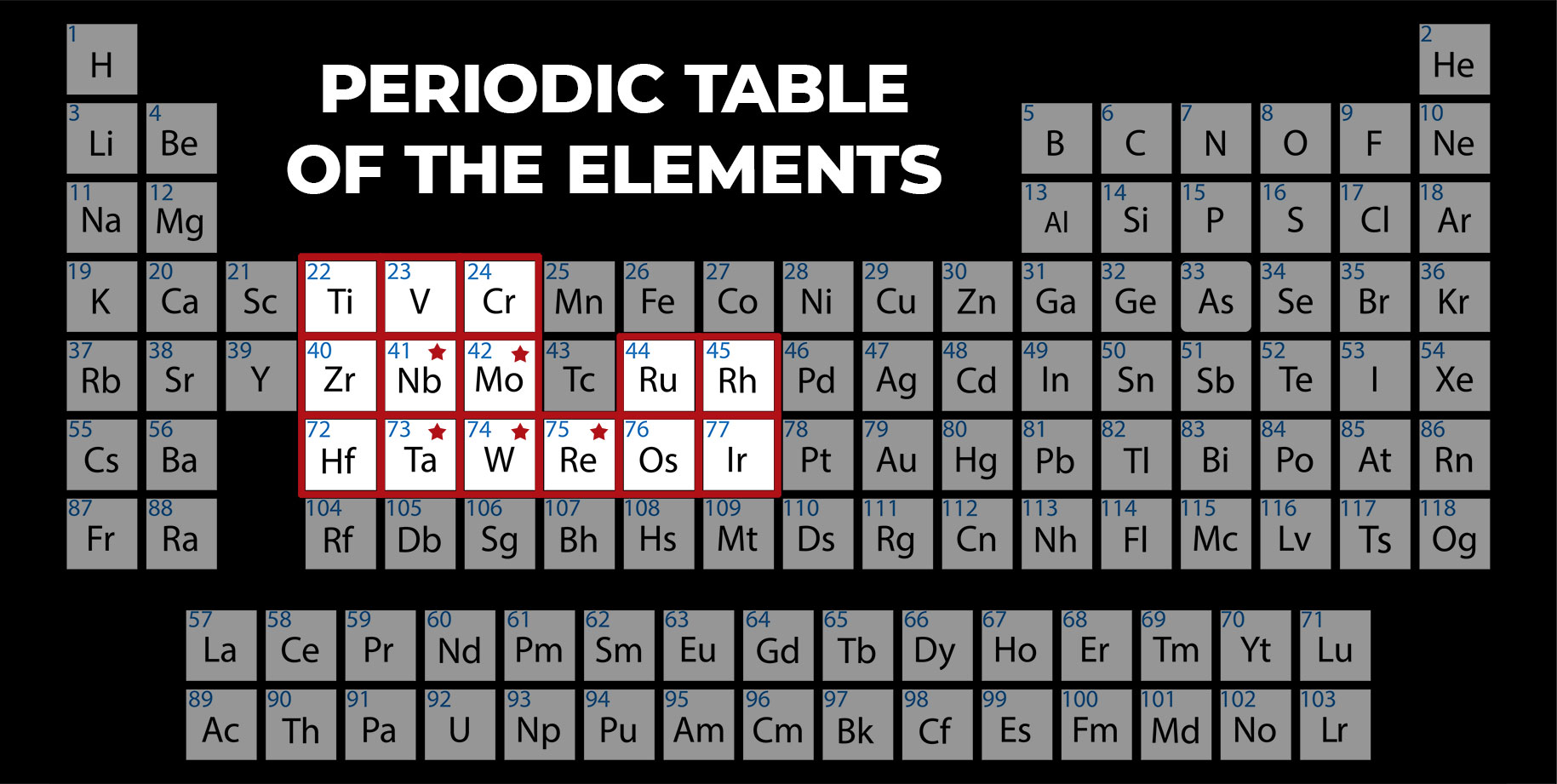Living in a Material World: What You Need to Know About Exotic Metals, Refractory Metals, and Specialty Metals

While they might seem interchangeable at times, exotic metals, refractory metals, and specialty metals and alloys occupy distinct spaces in the material world. Let’s explore their unique properties, common sources, and some concentrations that influence their availability, along with the industries that rely on their remarkable capabilities.
Exotic Metals: Rarities with Remarkable Properties
Exotic metals are a select group with special properties distinguished as uncommon. These properties can include characteristics like exceptional strength-to-weight ratios, high melting points, or superior resistance to damage from corrosion or extreme temperatures. The definition of “exotic” can be subjective depending on factors like:
- Rarity: How readily available the metal is in the Earth’s crust
- Cost: How expensive the metal is to mine and process?
- Properties: The unique characteristics that make it valuable for specific applications
Sources and Uses of Exotic Metals
Geographic concentrations are significant for exotic metals. Beryllium, for example, has major deposits in the United States, China, and Russia. Common sources include specialized mines and processing facilities due to their rarity. Exotic materials are used extensively for essential applications in major industries, including:
- Aerospace (rocket engines, lightweight components)
- Nuclear Energy (reactor components)
- Medical Devices (implants).
Examples of Exotic Metals
Providing an exhaustive list of exotic metals can be tricky, because the term itself is not a strictly defined scientific category, therefore, some metals might be considered exotic in certain contexts but not in others. However, here are some commonly recognized examples of exotic metals:
- Beryllium
- Gallium
- Germanium
- Hafnium
- Indium
- Lithium
- Rhenium
- Scandium
- Tantalum
- Titanium
- Yttrium
The properties of some of these exotic metals, like Tantalum, might also classify them as refractory metals. Their rarity and complex processing requirements can mean you need special metallurgy expertise to know exactly how to order and work with them.
Refractory Metals: Masters of High Heat
Refractory metals are the ultimate fire tamers. Renowned for their ability to withstand extremely high temperatures without melting or losing strength, these metals are ideal for applications exposed to intense heat.
Sources and Uses of Refractory Metals
Geographic concentrations play a role here as well, with China being a major producer of Tungsten ores and raw materials.. Refractory metals come from mining and processing operations focused on specific refractory metal ores near their sources. Key industries and applications for refractory metals include:
- Furnaces (heat shields, heating elements)
- High-performance Lighting (filaments)
- Medical Equipment (x-rays, radiation, cauterization)
- Aerospace (rocket propulsion nozzles).
Examples of Refractory Metals
Similar to exotic metals, there isn’t a universally agreed-upon definition for “refractory metals,” but there’s a well-established group with the most common characteristics. Here are the core refractory metals:
- Molybdenum (TZM)
- Niobium (Columbium)
- Rhenium
- Tantalum (sometimes falls under both exotic and refractory categories)
- Tungsten (Wolfram)
A broader definition of refractory metals might include additional elements that exhibit high melting points and resistance to heat, though they may not be as widely used as the core group. These additional elements can include:
- Chromium
- Hafnium
- Iridium
- Osmium
- Zirconium
It’s important to remember that the line between these categories can be blurry. Tantalum, for instance, exhibits properties that make it both exotic and refractory. The key takeaway is that you need to deeply understand these high-temperature performers’ unique properties to leverage their strengths in various applications.
Other Specialty Metals and Alloys: Engineered for Performance
Specialty metals and alloys are a diverse group, specifically chosen for their properties that cater to particular applications. Although less common than everyday metals like iron or aluminum, specialty metals are more common than exotic metals and are often readily available. Metal alloys are mixtures of two or more elements, at least one of which is a metal. Kovar®, for example, is an alloy made up of iron, nickel, and cobalt.
It’s not a tightly defined category, partly because the classification can change based on usage. A metal might be considered “specialty” for a particular industry due to its unique properties that cater to that specific use case. For instance, high-speed steel is a specialty metal for the metalworking industry but not necessarily for general construction. The classification is further complicated by innovation. New alloys are continuously developed with tailored properties, expanding the definition of specialty metals.
Sources and Uses of Refractory Metals
Specialty metals are sourced through mining operations and refined from commonly occurring ores. Geographic concentrations can exist depending on the specific metal. For example, Nickel has major deposits in Russia, Canada, and Indonesia. Top industries and applications using specialty metals and alloys include:
- Oil & Gas Drilling (corrosion-resistant pipes)
- Medical Devices (surgical instruments)
- Chemical Processing Equipment (reactors, vessels)
Examples of Specialty Metals and Alloys
Like refractory and exotic metals, providing an exhaustive list of all specialty metals and alloys is challenging because the category encompasses a diverse range based on specific functionalities. However, we can offer some common examples categorized by their general applications:
High-Performance Alloys:
- Nickel Alloys (Inconel, Monel): Offer exceptional strength, corrosion resistance, and high-temperature performance. Used in jet engines,
- chemical processing equipment, and offshore oil rigs.
- Cobalt-Chrome Alloys: Known for their biocompatibility, wear resistance, and high strength. Used in medical implants, jet engines, and cutting tools.
- High-Speed Steels: Engineered for exceptional hardness and ability to cut through tough materials at high speeds. Used in metalworking tools, drills, and machine parts.
- Tool Steels: A broad category with various types specifically formulated for different cutting, forming, and shaping applications.
Corrosion-Resistant Alloys:
- Stainless Steels (300 and 400 series): Offer superior resistance to corrosion and staining. Used in cookware, medical instruments, architectural cladding, and automotive parts.
- Hastelloy Alloys: A family of nickel-chromium-molybdenum alloys known for exceptional resistance to a wide range of corrosive environments. Used in chemical processing equipment, pollution control systems, and marine applications.
Other Specialty Alloys:
- Shape Memory Alloys: Exhibit the unique ability to “remember” their original shape after being deformed. Used in eyeglasses frames, orthodontic wires, and certain medical devices.
- Magnetic Alloys: Possess specific magnetic properties used in transformers, electric motors, and data storage devices.
- This is just a start. Remember, the “specialty” designation depends on the specific application and desired properties.
Living in a Material World of Specialty, Refractory, and Exotic Metals
Understanding the unique properties of these metal categories allows engineers and manufacturers to push the boundaries of performance across various industries. From the workhorse applications of specialty metals to the cutting-edge uses of refractory and exotic metals, these materials play a vital role in shaping the technological landscape, product performance, and production costs.
Contact us to discuss specialty, refractory, and exotic metals or request a quote to cut right to the chase. Sign up to receive our monthly newsletter, and join the conversation on LinkedIn.
If you still need more information, visit the American Society for Metals (ASM International), a highly reputable professional society dedicated to the advancement of materials science and engineering. They offer access to a wealth of technical information on metals.


